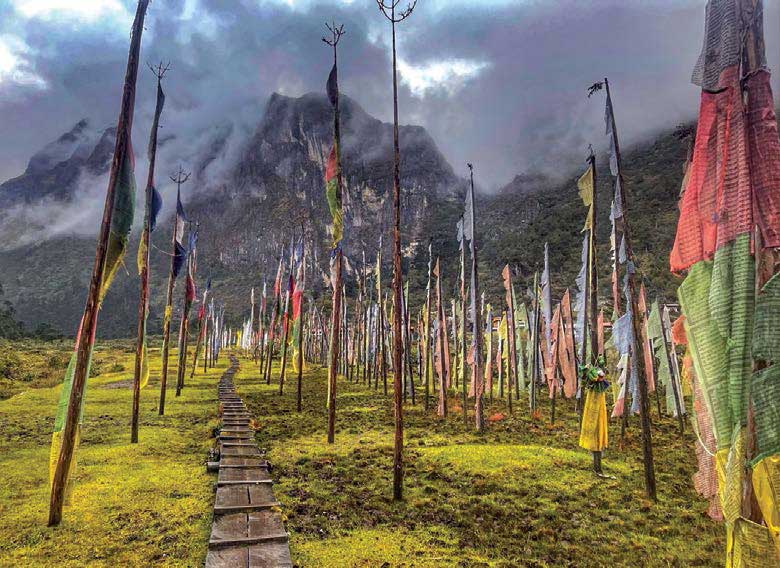Call it superstition or faith, Bhutanese people believe that all lakes are dwellings of spirits and local deities with mystical powers, and thus, sacred. Any disturbance or defilement to the lakes would potentially cause natural disasters or bad weather. Some lakes in particular are revered due to its connection to the lives of Buddhist saints.
Drakey Pangtsho, located on the northern side of Paro Dzongkhag, on the lap of a rocky cliff, is a popular pilgrimage destination for hikers. The eighth century Buddhist saint Guru Rinpoche, who spread Buddhism in the Himalayan belt, is believed to have hidden sacred termas (treasures) in the lake, drawing hundreds of pilgrims to this lake every year.

The original name of the lake is Drakey Phamtsho, which literally means “lake on the lap of Juwo Drake – the guardian deity of Paro Valley”. According to legends, the deity Juwo Drake is said to have offered the lake to Guru Rinpoche to house precious sacred treasures. Therefore, the lake is also considered a Treasure Lake.
According to one local account, the lake is known as Drakey Phamtsho loosely translating into “lake on the lap (Pham) of a cliff (Drak)”. This treasure lake is in the middle of a rocky hill at an altitude of 4,390m.
The 5th Dharma Master of Shaladrago, Yongdra Gyatsho, is said to have performed extraordinary spiritual stunts by going in the lake carrying a butter lamp on his head and meditating in the lake. He returned to the surface after a week, carrying sacred treasures, his clothes dry and the butter lamp still lit. This legend is reminiscent of how the 15th century Terton (treasure revealer) Pema Lingpa jumped into the famous Mebar Tsho in Bumthang with a burning butter lamp and emerged with sacred treasures and the lamp still burning.
According to another local account, one of the Shaladrago masters used to throw away offerings he received at faraway places and then retrieved them from Drakey Pangtsho. Such oral narratives make the lake a site of spiritual quest for many Bhutanese pilgrims. Even today, people believe one can see emanations of different treasures in the lake and hear mystical sounds of spiritual activity on auspicious days, of course depending on one’s karmic fortune and devotion.
The pilgrimage hike to Drakey Pangtsho starts from Bjana Goenpa (Monastery). Taking a Bolero Camper or a sturdy off-road vehicle is the best option as the dirt road from Drukgyel Dzong leading to the monastery can be extremely difficult to navigate. The road conditions further deteriorate during rainy season. The Goenpa is one and half-hour drive from Drukgyel Dzong.
The hike from the Goenpa towards the lake is roughly 6km and takes around 6-7 hours for slow hikers and around 4-5 hours for seasoned hikers. The return journey from the lake takes 3-4 hours with the trail going through steep rocky slopes back to the Goenpa.

There are other options to reach the lake. One is from Norbuling Rigter College in Paro and the other from Bumdra, above Taktsang Monastery. The hike from Bumdra takes about
three hours to reach the lake while it takes 4-5 hours from the College. The hike from the College via Shaladra offers the opportunity to visit two lakes on the way namely Goratsho (Court-yard Lake) and Zimpontsho (Chamberlain Lake). You will also come across a meditation cave of Karma Pelbar, one of the the Dharma Masters of Shaladrago.
The trail mostly runs through rocky slopes and vegetation of alpine shrubs. The trail from the Goenpa is uphill till the laptsha (pass), from where you can see the first lake – Yumtsho.
The hike to the sacred treasure lake is strenuous, and hikers can be vulnerable to altitude sickness due to the steep rise in altitude. The trail is rocky and proper trekking shoes should be worn. First time trekkers should take along sugary drinks and chocolates to beat altitude sickness. The best time to visit Drakey Pangtsho is from March to October.

Passang Tshering
He is a qualified tour guide (culture and trekking). He leads tour groups across Bhutan. He enjoys photography and Facebook and Instagram blogging. You can follow him on Facebook and Instagram @bhutanwithpassang.



